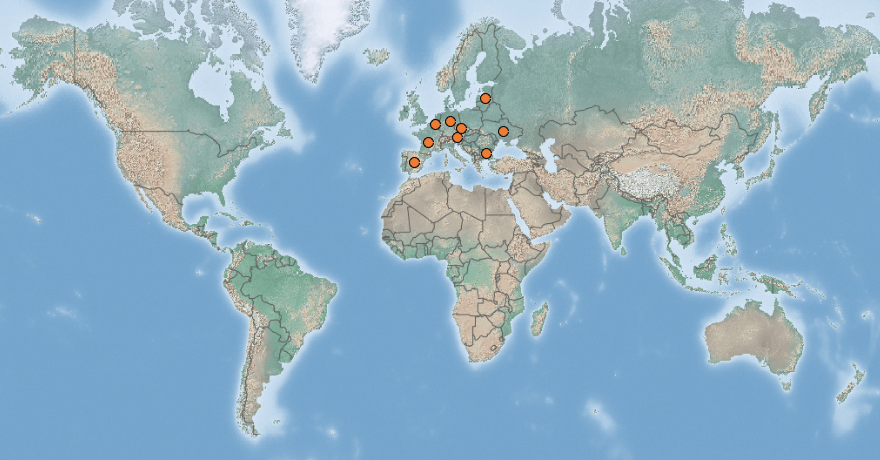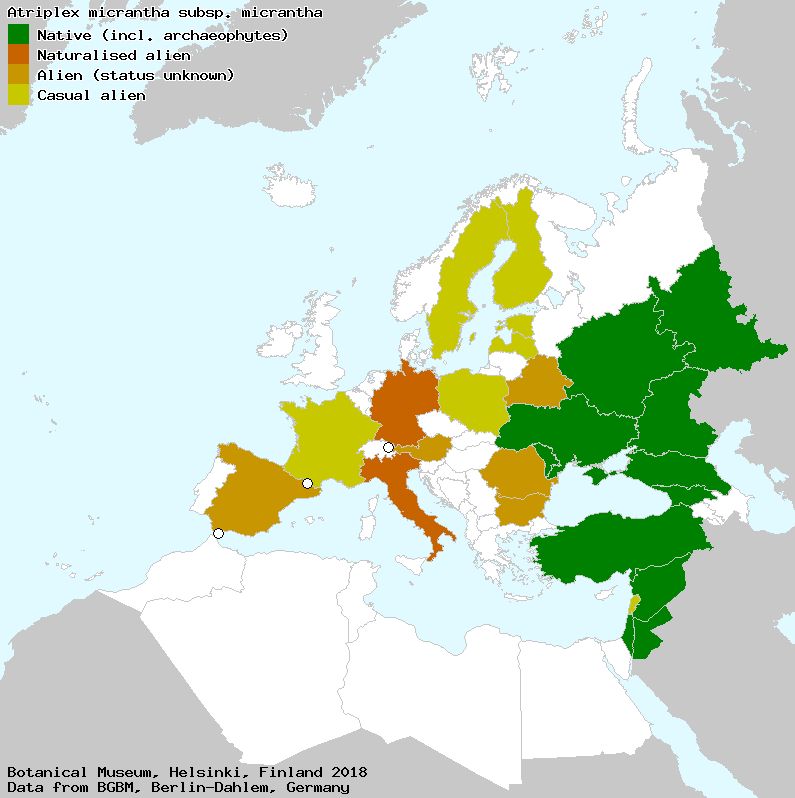 |
n/a | Status LU: established. 1st record: LU & ITW 2007. |
 |
Verschiddesomeg Méil | Status Eur.: established. 1st record: FR 1906. |
 |
Arroche hétérosperme | RA: ISEIA: C2. Harmonia+: 0,09 |
 |
Verschiedensamige Melde | Wikipedia:  | Wikispecies: | Wikispecies: |
 |
Grijze melde | Back to the list of neophytes |
Contents
Report the species
→ Report Atriplex micrantha to the National Museum of Natural History.
Brief description
In its native Central Asia, Atriplex micrantha Ledeb. grows in steppes on saline soil, on the shores of water, or in the steppe and semi-desert zone. The species was introduced into large parts of Europe through trade and traffic. It was probably unintentionally introduced to Central Europe from Russia with grain supplies. Its first finds date from 1906 in Alsace (Rhine port). From there, it has spread out strongly along the waterways and traffic routes in recent decades (Wikipedia contributors 2019).
Status and distribution in Luxembourg
Records of Atriplex micrantha Ledeb. in Luxembourg. Data source: Recorder-Lux, iNaturalist & GBIF, 2025-12-09.
The annual halophyte Atriplex micrantha Ledeb. (syn.: A. heterosperma Bunge), once known as a very rare weed, began to naturalize in the flora territory in 2003. It spread rapidly along motorways, entering this territory apparently from the east and southwest (Germany and French Lorraine) (Lambinon & Verloove 2012: 168).
The species was first spotted in Hellange (Municipality of Frisange) on 14 October 2007, in a roundabout at a construction site on controlled-access highway E29 (Weicherding 2007, MNHNL 2000-, herbarium nr 22483).1
Since this single observation, the species managed to invade the Luxembourg highway network unnoticed, until a large population was spotted in summer 2015 in Potaschberg on the A1 highway between Trier and Luxembourg (Krippel & Colling 2016: 30).2
A field inspection in autumn 2015 revealed the invasive plant grows in the median strip of the A1 almost from the German border until Luxembourg city in huge very dense populations3, which confirms the Belgian point of view that “the species is still insufficiently known and widely neglected”.4 Atriplex micrantha, which was dominant in the middle part of the median strip, occurred together with the following species: Senecio inaequidens (dominant on the borders of the median strip), Mercurialis annua, Plantago intermedia, Prunus spinosa and Rosa rugosa.
On 13 October 2015 the species was spotted along the Jersey barrier of highway A6 between the Belgian border and Mamer5.
Since then the species managed to travel north along the A7 highway until Colmar-Berg and the B7 national highway until Ettelbruck (Krippel et al. 2018: 60). Since then, the expansion of the species is ongoing along these highways (Krippel et. al 2020: 33).
Atriplex micrantha is very salt-tolerant and benefits from the extensive use of de-icing salt along motorways during winter. It probably arrived in Luxembourg via its large secondary distribution area in Germany, namely the A1 from Trier. It is present in our neighbouring regions in Belgium (Verloove 2006), Lorraine (Georges 2006) and Saarland (Weicherding 2007).

Atriplex micrantha in the median strip of the A1 highway near Potaschberg. Photo: Jim Meisch, 08.10.2014.

Atriplex micrantha in the median strip of the A1 highway near Potaschberg, together with Senecio inaequidens. Photo: Jim Meisch, 08.10.2014.
Risk assessment
ISEIA protocol
C2 (3+1+1+1). First assessed 16 February 2017 by Yves Krippel and Christian Ries.
Harmonia+ protocol
Overall risk score 0,09 = (Overall Invasion score 0,36 x Overall Impact score 0,25) (Ries et al. 2020).
 Invasion
Invasion0,25

 Impact
Impact0,09

 Risk
RiskWorldwide distribution
Bibliography
- Georges, N., 2006. Note sur deux nouvelles espèces de Chenopodiaceae adventices en Lorraine : Bassia scoparia (L.) Voss et Atriplex micrantha Ledeb. Willemetia 48: 1-4. [PDF]
- Krippel, Y. & G. Colling, 2016. Notes floristiques. Observations faites au Luxembourg (2014-2015). Bull. Soc. Nat. luxemb. 118 : 27-51.
- Krippel, Y., T. Helminger & G. Colling, 2018. Notes floristiques. Observations faites au Luxembourg (2016-2017). Bull. Soc. Nat. luxemb. 120: 57-76. [PDF 265 KB]
- Krippel, Y., T. Helminger & G. Colling, 2020. Notes floristiques. Observations faites au Luxembourg (2018-2019). Bulletin Soc. Nat. luxemb. 122 : 29-55. [PDF 132 KB]
- Lambinon J. & F. Verloove, 2012. Nouvelle flore de la Belgique, du grand-duché de Luxembourg, du Nord de la France et des régions voisines. Sixième édition. Avec la collaboration de L. Delvosalle, B. Toussaint, D. Geerinck, I. Hoste, F. Van Rossum, B. Cornier, R. Schumacker, A. Vanderpoorten et H. Vannerom. Jardin botanique national de Belgique, Meise. CXXXIX + 1195 pp. ISBN : 9789072619884.
- MNHNL, 2000-. Atriplex micrantha Ledeb. in Recorder-Lux, database on the natural heritage of the Grand Duchy of Luxembourg. Musée national d’histoire naturelle, Luxembourg. URL: https://mdata.mnhn.lu [Accessed 2019-10-02]
- MNHNL, iNaturalist & GBIF, 2019. Atriplex micrantha Ledeb. in MNHNL-mdata, online portal combining species observation from Recorder-Lux, iNaturalist and GBIF. National Museum of Natural History, Luxembourg. URL: https://mdata.mnhn.lu [Accessed 2019-10-02]
- Ries, C. & Y. Krippel, 2021. First records of 56 invasive alien vascular plants in Luxembourg. Bulletin de la Société des naturalistes luxembourgeois 123: 115-127. [PDF 241 KB]
- Ries, C., Y. Krippel & M. Pfeiffenschneider, 2020. Risk assessment after the Harmonia+ protocol of invasive alien vascular plant species in Luxembourg. Bull. Soc. Nat. luxemb. 122: 197-205. [PDF 132 KB]
- Verloove, F., 2006. Atriplex micrantha, een nieuwe neofyt langs belangrijke verkeerswegen in België. Dumortiera 88: 15-20.
- Weicherding, F.-J., 2007. Zur Verbreitung und Soziologie der adventiven Melden Atriplex micrantha Ledeb. (Verschiedensamige Melde), Atriplex sagittata Borkh. (Glanz-Melde) und Atriplex oblongifolia Waldst. et Kit. (Langblättrige Melde) (Chenopodiaceae) im Saarland und in angrenzenden Gebieten. Abh. Delattinia 33: 117-139.
- Wikipedia contributors, 2019. Seite „Verschiedensamige Melde“ in Wikipedia, Die freie Enzyklopädie. Bearbeitungsstand: 1. Mai 2019, 23:11 UTC. URL: https://de.wikipedia.org/w/index.php?title=Verschiedensamige_Melde&oldid=188124273 [accessed 23 October 2019]
Suggested citation of this webpage
Ries, C., M. Pfeiffenschneider & Y. Krippel (Eds.), 2025. Atriplex micrantha Ledeb. In: neobiota.lu - Invasive Alien Species in Luxembourg. National Museum of Natural History, Luxembourg. URL: https://neobiota.lu/atriplex-micrantha/ [Accessed 2025-12-09].
Page content last updated on 2021-06-02. Last proofread by Caroline Grounds on 2019-11-13.
- Atriplex micrantha was first spotted in Luxembourg on 14 October 2007 by German Horticulturist Franz-Josef Weicherding, St. Ingbert/Saar. He offered a specimen to the herbarium of the MNHNL (Acc Nr. MNHNL 2011/47).[↩]
- Atriplex micrantha was spotted on 15 August 2015 by botanist Yves Krippel, scientific cooperator of the National Museum of Natural History.[↩]
- Inspection was carried out on 8 October 2015 by Dr Christian Ries and Dr Jim Meisch, curators at the National Museum of Natural History (WGS 84 6.41204, 49.68373). This “field trip” on the middle strip of a highway had to be coordinated with the highways unit of the department of civil engineering.[↩]
- Cf. Atriplex micrantha in the Manual of the Alien Plants of Belgium[↩]
- The plants were smaller (± 40-50 cm) than on the A1 (± 150 cm). Observation by Dr Christian Ries while driving car in the mentioned direction.[↩]




